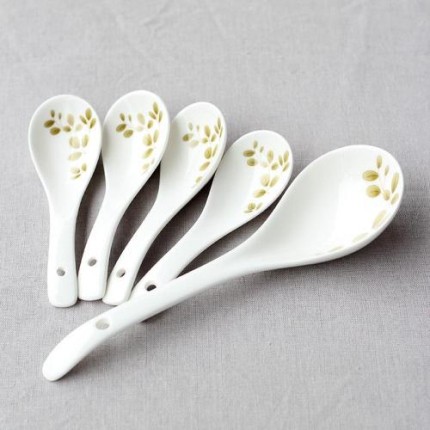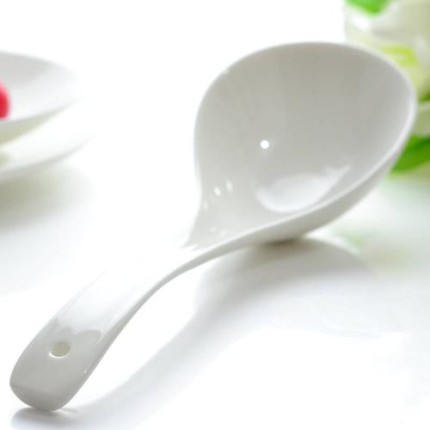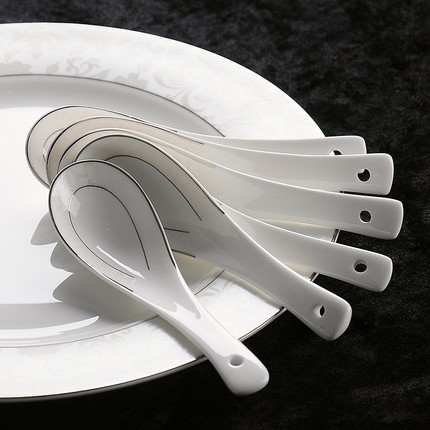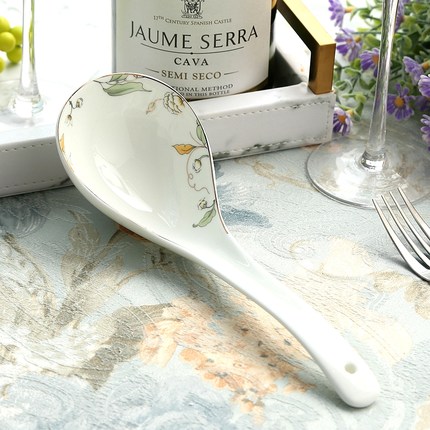Product Display
spoon
 Home > Product Display > spoon
Home > Product Display > spoon
spoon
Ceramic tableware is made from inorganic non-metallic minerals such as clay through processes of mixing, shaping, and high-temperature firing. Its history can be traced back to the Neolithic Age, and it combines practicality and artistic value. The following is an introduction from multiple dimensions:
I. Core Categories and Characteristics
Classification by Material and Process
Porcelain: Mainly made from kaolin, fired at a temperature of ≥1200°C, with a dense and translucent texture. For example, bone china (containing ≥40% bovine bone powder, lightweight and impact-resistant), and white porcelain (Dehua white porcelain is known for its purity).
Pottery: The raw materials contain ordinary clay, fired at a temperature of 800 - 1200°C, with a relatively high porosity. For example, Yixing purple clay (belongs to stoneware, with good air permeability).
Stoneware: It is between pottery and porcelain, with a water absorption rate of ≤6%, high strength, and good thermal stability. It is commonly used in industrial and daily scenarios (such as acid-resistant chemical ceramics).
Differences in Decoration Techniques
Underglaze Color: Painted on the surface of the green body, after glazing, it is fired at a high temperature. The pattern is covered by the glaze layer, and there is no risk of lead and cadmium dissolution (such as blue and white porcelain).
Overglaze Color: Painted on the glaze surface, fired at a low temperature. The colors are bright, but improper processes may lead to heavy metal migration, and there is a bumpy feeling when touched.
In-glaze Color: The process is between the above two. The pattern is partially embedded in the glaze layer, balancing safety and aesthetics.
Modern Sub-categories
Magnesia Porcelain: Contains talc, with high whiteness and strength, often used in star-rated hotels.
Strengthened Porcelain: Added with aluminum and magnesium components, with strong impact resistance, suitable for mechanical washing.
Shell Porcelain: Added with shell powder, the glaze surface has a bluish tint in white, with outstanding cost performance.
II. Safety and Purchase Points
Health Risks and Avoidance
Lead and Cadmium Dissolution: Inferior glaze materials or improper processes may lead to heavy metal migration. A test by the Consumer Council of Hong Kong showed that about 35% of the samples detected lead (up to 1.00mg/L), and 13% detected cadmium, but all met international standards (lead ≤ 7mg/L, cadmium ≤ 0.5mg/L).
Purchase Suggestions:
Avoid products with overly bright colors or inner wall paintings. Give priority to underglaze color or in-glaze color products.
Check whether the inner wall is smooth. Soak it in vinegar for 2 - 3 hours to observe if it fades.
Look for products from regular channels and with quality inspection marks, and avoid "three-no" products.
Adaptation to Usage Scenarios
Microwave Applicability: Avoid products with metal decorations (such as gold rims). Choose products marked "microwave available".
High-temperature Disinfection: Magnesia-strengthened porcelain, stoneware, etc. can withstand dishwasher and high-temperature cooking, suitable for the catering industry.
III. Manufacturing Process and Cultural Value
Traditional Process Flow
Raw Material Treatment: Clay is mixed with feldspar, quartz, etc., and impurities are removed.
Shaping: Shaped by hand throwing, casting, or pressing. After drying, the green body is trimmed.
Glazing and Firing: The glaze covers the green body and is sintered at a high temperature of 1200 - 1400°C to form a vitreous surface.
Decoration: Overglaze color requires a second low-temperature firing (700 - 850°C), while underglaze color is fired in one go.
Cultural Symbols and Modern Innovation
Historical Inheritance: From the celadon in the Shang Dynasty to the blue and white porcelain in the Yuan Dynasty, ceramic tableware carries the genes of Chinese food culture. For example, the tableware for the "West Lake Feast" at the G20 Summit in 2016 showcased oriental aesthetics with celadon and gilding techniques.
Design Trends: New-generation designers integrate traditional elements with modern technologies. For example, the "Magnificent Dunhuang" series extracts mural images and interprets new cultural charm through glaze colors and shapes. Environmentally friendly materials (such as lead-free glaze) and functional technologies (antibacterial glaze, nano-coating) have become the focus of research and development.
IV. Maintenance and Usage Tips
Daily Maintenance
Cleaning: Clean with a soft cloth or sponge to avoid scratching with hard objects; for bone china, toothpaste can be used to gently polish scratches, and lemon juice can be used to remove tea stains.
Storage: Avoid stacking and squeezing. Use dividers to prevent collisions.
Taboos
Ceramic tableware has poor thermal conductivity. Sudden temperature changes may cause cracking. It is recommended to preheat before use.
Avoid storing acidic foods (such as vinegar, fruit juice) for a long time to reduce the risk of heavy metal migration.
V. Industry Status and Future Directions
Market Trends
In 2025, the global ceramic tableware market size is expected to reach 73 - 75 billion yuan. China accounts for over 55%. High-value-added categories such as strengthened porcelain and bone china have a leading growth rate (an average of 8.3% per year).
Cross-border e-commerce has become an important channel. The demand in Southeast Asia, Europe, and the United States is strong, but it is necessary to respond to the new EU standards for lead and cadmium migration (such as the new regulations in 2024 forcing out backward production capacity).
Technological Innovation
Intelligent Production: Production areas such as Jingdezhen and Chaozhou are promoting automated transformation. The production line efficiency has increased by 40%, and the unit cost has decreased by 8 - 10%.
Function Expansion: Spodumene-strengthened porcelain can withstand a temperature difference of -20°C to 260°C, and the anti-fouling performance of nano-coated porcelain has increased by 3 times, meeting the needs of special scenarios such as aviation and medical care.
Ceramic tableware is not only a carrier of food culture but also continuously meets the modern people's pursuit of health, aesthetics, and personalization through the iteration of materials, processes, and designs. When choosing, considering safety, practicality, and cultural connotations can truly make "beautiful utensils" light up life.








